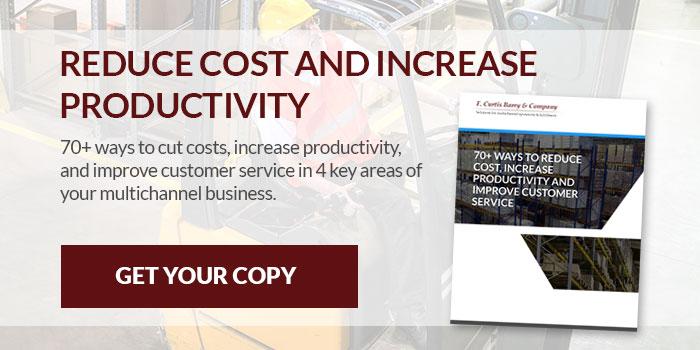In our experience, more than 50% of the time, major fulfillment center projects such as a new WMS installation or an automation enhancement are not implemented on time or within budget. The solutions and new processes a WMS allows for can cause major changes to how inventory is managed, and the ways orders are fulfilled. It can take months for workers to achieve the expected productivity gains and for companies to get back to and exceed the same level of throughput as before the new system.
Simply trying to recreate existing processes, without change, in a newly installed WMS is a waste of time and money. WMS solutions will deliver industry best practices and processes, companies must consider all the changes necessary to maximize these new capabilities. This includes changes in responsibilities, integrating technology such as handhelds, and how everyday processes are impacted.
To unlock the full potential of your WMS, here are 9 factors to consider when implementing your new WMS:
1. Select The WMS Which Gives You The Most Benefit, Future Flexibility, Function, And Scalability.
Installing a full-function WMS is the first step in increasing productivity and establishes a foundation to build on. WMS vendors may have preferred partners but don’t assume that’s always the best choice for your company. The interfaces and integrations they develop are often of considerable value. However, we recommend selecting the WMS that best fits your company size, the functionality required, and has a total cost of ownership that is acceptable.
Some vendors offer multiple flavors of WMS functionality. This can make it very attractive to start with a more basic offering and then grow within the system as your business grows. It's much easier to implement additional functionality within the same system environment than to change WMSs completely again.
2. Understand The New Processes In Conjunction With The WMS.
As you begin evaluating various WMS solutions, you will begin to understand how your current processes will need to change. Strive to understand the process changes that will be necessary. As with most new systems, most every process will change to some degree, even though the end result may be the same. Change management becomes a key role during the implementation of a new system.
3. Consider Changes In Organizational Responsibilities.
As part of these projects, consider changes in organizational responsibilities. For example, consider the use of weights and measures in a new WMS. Who specifically will be responsible for capturing an item's cubic dimensions and weights. Will this come from product development as the item is created, or by inventory control - or will receiving be responsible for capturing this as new items are received on the dock.
Recognize that implementing new processes and systems will challenge existing responsibilities and territories. How will the project team determine the best option(s) for change, and be sure that SOPs are developed and implemented?
4. Involve Key Employees In All Decisions.
The earlier you involve key employees in major projects such as these, the better the chance of getting their buy-in and ultimately achieving successful outcomes. Involvement over time helps them get acclimated to the changes you are considering.
Often, function-specific employees, such as receivers, may have a problem that the system can help achieve but would never have been known about by upper management alone.
5. Help Staff Make The Transition.
We find that every organization has to have time to adjust to new systems, processes, and tools for performing their tasks. No matter the training, this takes time to adjust to the changes. Companies must consider the changes, and work with each department to ensure the staff is adjusting and acclimating to the new system. Some workers will be intimidated by new technology, and companies must develop a plan for assisting these individuals.
6. Plan For Productivity Loss.
One of the hardest points to deal with is getting management to understand and accept temporarily lower productivity during the start-up period, and the first few months after go-live. Some individuals will be very quick to adapt and reach their goals faster than others. Be realistic about how long it will take for the organization’s productivity as a whole to reach the expected new goals.
During vendor reference checks, ask the clients you interview what their experience has been in meeting budget and productivity goals. We find many companies will tell you their experience and what they would do differently.
7. Establish Realistic Project Plans, Schedules, And Estimates.
Each implementation is a major project in its own right. Project plans should be realistic and provide significant time for integration testing and end-user acceptance testing. Failure to properly test will result in the failed implementation of the WMS.
Additionally, ensure that the proper amount of time is planned for training. Many implementations include very detailed broad training for selected super users and trainers and then more specific functionality training for users in that job function.
8. Fine Tune The New Fulfillment Environment Post Implementation.
No implementation is perfect. Build tasks into the project plan to audit the implementation and make proposed changes. These may range from more training for certain people or departments or workflow adjustments to increase productivity and reduce backlogs.
There may even be a scenario where changing a newly implemented process may make sense after seeing it in live production versus the test environment.
9. Consider Using A Fulfillment Consultant To Supplement Staff.
Use consultants to complement your organization’s skill sets and to work through the process changes; recommend organizational changes; develop and manage the project plan, schedule and report status and advise on budget performance.
Gaining the synergy of process changes from a new WMS means realistic detail design and implementation for the outcomes that will achieve the ROI management expects.






SHARE